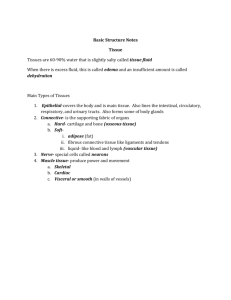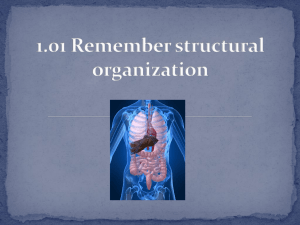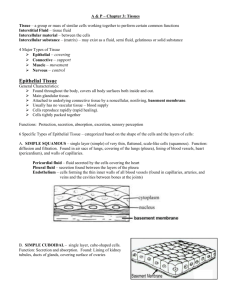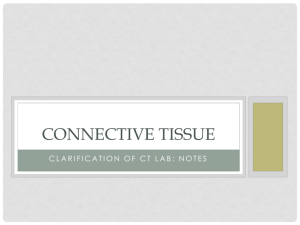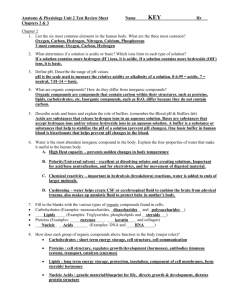Chapter 41 - Academic Web
advertisement
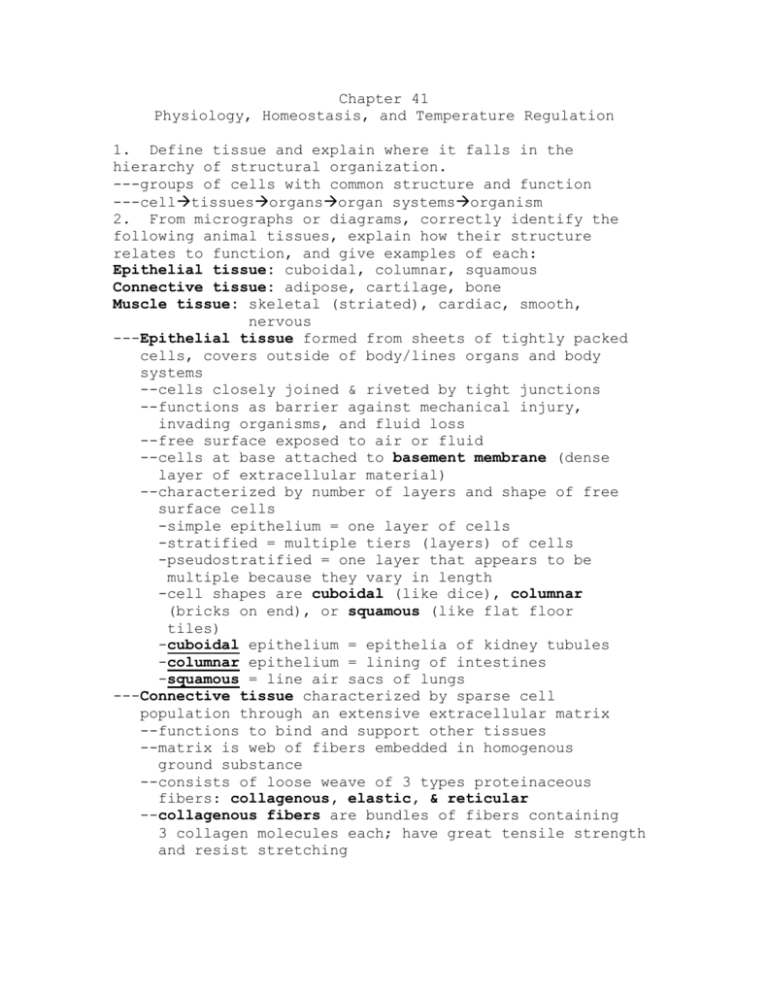
Chapter 41 Physiology, Homeostasis, and Temperature Regulation 1. Define tissue and explain where it falls in the hierarchy of structural organization. ---groups of cells with common structure and function ---celltissuesorgansorgan systemsorganism 2. From micrographs or diagrams, correctly identify the following animal tissues, explain how their structure relates to function, and give examples of each: Epithelial tissue: cuboidal, columnar, squamous Connective tissue: adipose, cartilage, bone Muscle tissue: skeletal (striated), cardiac, smooth, nervous ---Epithelial tissue formed from sheets of tightly packed cells, covers outside of body/lines organs and body systems --cells closely joined & riveted by tight junctions --functions as barrier against mechanical injury, invading organisms, and fluid loss --free surface exposed to air or fluid --cells at base attached to basement membrane (dense layer of extracellular material) --characterized by number of layers and shape of free surface cells -simple epithelium = one layer of cells -stratified = multiple tiers (layers) of cells -pseudostratified = one layer that appears to be multiple because they vary in length -cell shapes are cuboidal (like dice), columnar (bricks on end), or squamous (like flat floor tiles) -cuboidal epithelium = epithelia of kidney tubules -columnar epithelium = lining of intestines -squamous = line air sacs of lungs ---Connective tissue characterized by sparse cell population through an extensive extracellular matrix --functions to bind and support other tissues --matrix is web of fibers embedded in homogenous ground substance --consists of loose weave of 3 types proteinaceous fibers: collagenous, elastic, & reticular --collagenous fibers are bundles of fibers containing 3 collagen molecules each; have great tensile strength and resist stretching --elastic fibers are long threads of protein (elastin), lend tissue the resilence to quickly return to original shape --reticular fibers are branched, form tightly woven fabric joining connective tissue to adjacent tissues --major types: loose connective, adipose, fibrous connective, cartilage, bone, & blood --Adipose tissue is loose connective tissue specialized to store fat in adipose cells distributed throughout its matrix -insulates body and stores fuel molecules -each adipose cell has one large fat droplet -adipose tissue covers some internal organs --Cartilage is composed of collagenous fibers embedded in chondroitin sulfate (protein-carbohydrate ground substance) -chondrocytes secrete both collagen & chondroitin sulfate -makes cartilage both strong and flexible -chondrocytes confined to lucunae (scattered spaces within ground substance -comprises skeleton of all vertebrate embryos -retained in some areas: nose, ears, trachea, intervertebral discs, & ends of some bones --Bone is mineralized connective tissue -osteoblasts are bone forming cells-deposit matrix of coì¥Á M ð ¿ £! bjbjâ=â= ÿÿ ÿÿ l ¨ ¨ ¨ ¨ ¨ ¨ ¨ $ 2 2 2 2 F < $ 2 Ž Ž Ž Ž Ž Ž Ž Ž $ É é p < ¨ Ž Ž Ž Ž Ž ¨ < ¢ Ž ¢ Ž ¨ Q ¢ Ž ¨ Ž ¨ Ž ¢ Ž ¢ ¢ t ¢ ¨ Ž 2 ‚ ¨ @m²3˜Â$ ˜ g 0 Y ¢ Y ¢ < ø , ¨ ¨ ¨ ¨ Ù Chapter 40 An Introduction to Animal Structure and Function 1. Define tissue an explain where it falls in t e hierarchy of structural organi ation.---groups of cells with common structure and unction---cell(tissues organs(organ systems(organism2. From micrographs r diagrams, correctly identify the following anima tissues, explain how their structure relates to fun tion, and ive examples of each:Epithelial tissue: cuboidal, column r, squamousConnective tissue: a ipose, cartilage, boneMuscle tissue: skeletal (striated), ardiac, smooth, nervo s---Epithelial tissue formed from sheets of tightly acked cells, covers outside of body/lines organs and bod ¼ systems --cells closely joined & rive ed by tight junctions --functions as barrier against mechanical injury, invading organisms, and fluid loss --free surface exposed to air or fluid --cells at base attached to basement membrane (dense layer of extracellular material --characterized by number of layers and shapeange of of dissolved oxygen, nutrients, & wastes --this imposes constraints to animal size and shape ---most complex animals have a smaller surface area to volume ratio and thus lack adequate exchange area on the outer surface ---instead, highly folded, moist, internal surfaces exchange materials with environment ---circulatory system shuttles materials between these specialized exchange surfaces ---environmental exchange surfaces are internal & protected from desiccation, so animal can live on land ---cells are bathed with internal body fluid, so the animal can control the quality of the cells’ immediate environment 4. Describe several body shapes that maximize external surface area in contact with the environment. ---single-celled organisms have entire surface area in contact with environment ---two-layered sac, utilized by some multicellular animals, has body wall only 2 cell layers thick (body cavity of Hydra) ---flat-shaped body with maximum surface area exposed to aqueous environment (tapeworm thin and flat so most cells bathed in intestinal fluid of the worm’s vertebrate host ---highly folded, moist, internal surfaces (most complex animals) 5. Repeat of question 3. 6. Describe the location and function of interstitial fluid. ---interstitial fluid is the fluid between the cells that comprise the internal environment of vertebrates --fills spaces between the cells --exchanges nutrients and wastes with blood carried in capillaries 7. Define homeostasis. ---homeostasis is dynamic state of equilibrium in which internal conditions remain relatively stable, “steady state” --allows organism to maintain (fairly) constant conditions in internal environment even when external environment changes 8. Distinguish between negative and positive feedback. ---negative feedback is homeostatic mechanism that stops or reduces the intensity of the original stimulus and consequently causes a change in the variable that is opposite in direction to the initial change --most common homeostatic mechanism in animals --lag time between sensation and response so variable drifts slightly above and below set point thermostatic control of room temperature ---positive feedback is homeostatic mechanism that enhances the initial change in a variable --rarer than negative feedback/controls episodic events --examples are blood clotting and childbirth
